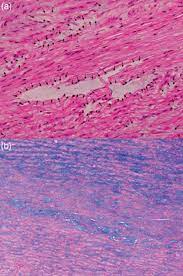 Cystic medial necrosis (CMN) is a pathological condition that affects the walls of blood vessels, particularly arteries.
Cystic medial necrosis (CMN) is a pathological condition that affects the walls of blood vessels, particularly arteries.
It is characterized by degeneration and weakening of the muscular and elastic fibers in the middle layer of the arterial wall, known as the media.
CMN most commonly occurs in large and medium-sized arteries, such as the aorta, but can also affect other arteries in the body.
The exact cause is not fully understood: genetic predisposition, connective tissue disorders, such as Marfan syndrome and Ehlers-Danlos syndrome, hypertension and aging are associated.
It is caused by collagen linking defects leading to deposition of basophilic ground substance in the media, creating cyst-like lesions that weaken the artery wall.
In CMN, the media of the arterial wall undergoes degenerative changes, leading to the formation of cyst-like spaces or cavities within the tissue.
These changes result in the affected artery becoming weaker, less elastic, and more prone to dilation and aneurysm formation.
In some cases, the weakened arterial wall can rupture, leading to potentially life-threatening complications: CMN is often associated with aortic aneurysms and dissections.
The diagnosis of CMN is typically made through imaging studies: such computed tomography (CT) scan, magnetic resonance imaging (MRI), or echocardiogram.
Treatment options: Include medical management of associated risk factors, such as blood pressure control, surgical interventions, such as aortic repair or replacement, or endovascular procedures to repair or reinforce the weakened arterial wall.
CMN is a disease of large arteries, especially the aorta.
The incidence of CMN increases with age, and it is thought to be the cause of 1%-6% of thoracic aortic aneurysms.
This condition does not typically affect children.
Aortic aneurysms are typically asymptomatic.
Aortic aneurysms are often found on CT scans as an incidental finding.
Complications like aortic dissection or rupture present with acute onset of severe chest, back, or abdominal pain.
A pulsatile mass can be felt in abdominal aortic aneurysms.
The aneurysm can compress adjacent structures if rapidly expanding, leading to hoarseness, dysphagia, or wheezing.
Hemodynamic instability with hypotension occurs in aortic rupture. Mortality is very high in a ruptured aortic aneurysm.
